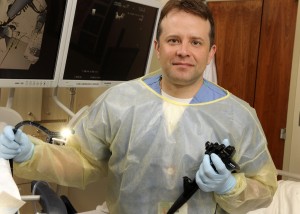Once esophageal tumors establish themselves, a patient’s prognosis is grim and morbidity vast. But when lesions are caught early and removed, especially in the premalignant stage, the odds of survival markedly improve.
When a case calls for it, Emory gastroenterologist Field F. Willingham, MD, MPH, uses a hybrid approach to ousting superficial esophageal lesions. Superficial esophageal lesions are commonly caused by acid reflux disease, or GERD. GERD occurs when stomach acid flows into the esophagus and can lead to a condition known as Barrett’s esophagus, where the cells in the lower esophagus become damaged. This in turn can lead to dysplasia, or pre-cancerous cells.
But for superficial cancers, it is now possible to remove a portion of the lining layer of the GI tract, containing the tumor, with an endoscope. This can help carefully selected patients avoid a major surgery. The technique, known as an EMR, allows the removal of superficial esophageal tumors and pre-cancer with an endoscope, a slender tube-like instrument.
Detecting and removing esophageal tumors early is essential for a favorable outcome. Once tumors firmly establish themselves in esophageal tissue, the prognosis is grim and morbidity vast. In the past, a diagnosis of an esophageal tumor meant the removal of the esophagus and often the stomach. But now EMR can be used in tandem with radio frequency ablation.
In surgical situations in which radio frequency ablation is not feasible, Willingham and his colleagues are beginning to use an alternate technique, known as cryotherpay, in tandem with EMR. Cryotherapy involves freezing superficial cells to rid the esophagus of suspect cells.
“So, if the end of the esophagus is twisted, or if we can’t touch it with this balloon device, then we can use cryotherapy,†says Willingham. “We’re trying to kill the lining layer with the tumor cells without killing the deeper layer.â€
Willingham and his colleagues are seeing evidence that using these very three very different, technologies in tandem or alone will provide patients with a better way to rid them of esophageal lesions while preserving their quality of life.






